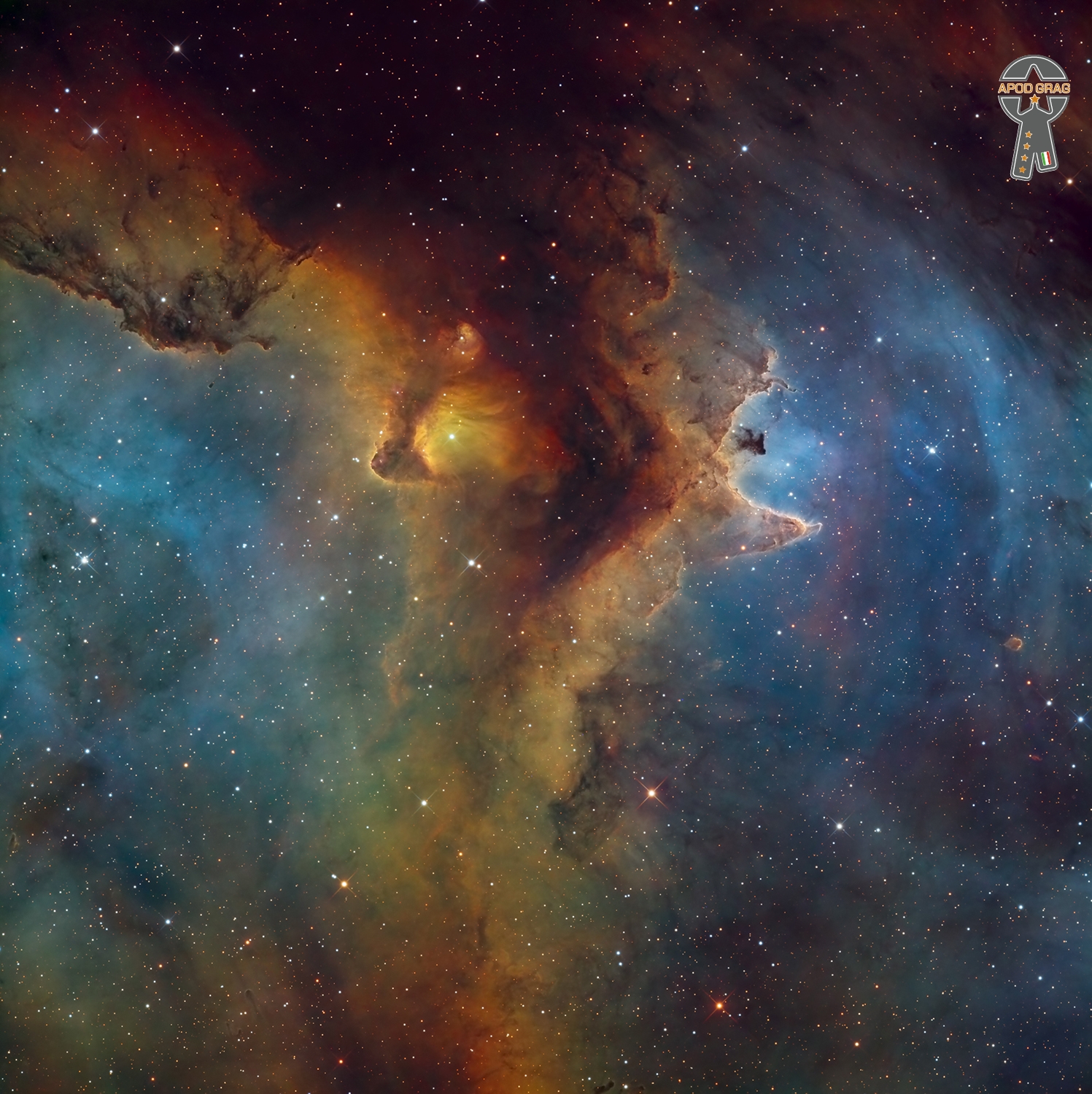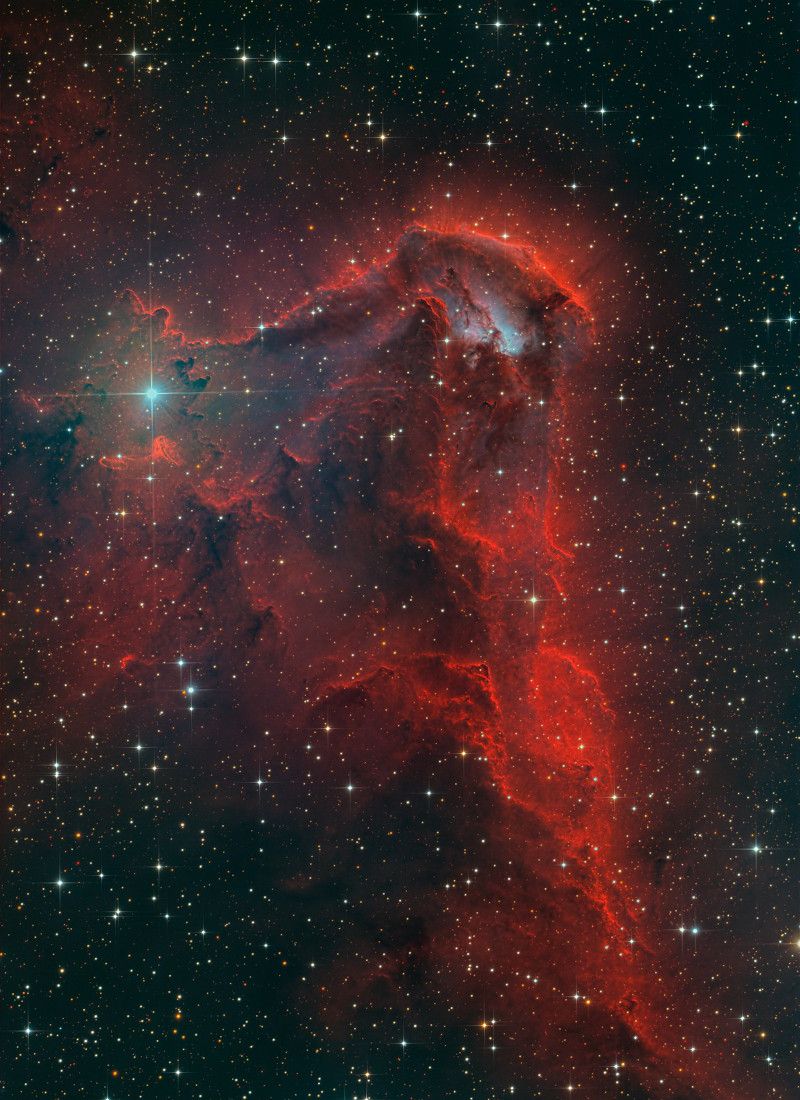Blog
Eli “Lucky” Thompson (June 16, 1924 – July 30, 2005) was an American jazz tenor and soprano saxophonist whose playing combined elements of swing and bebop.Although John Coltrane usually receives the most credit for bringing the soprano saxophone out of obsolescence in the early 1960s, Thompson (along with Steve Lacy) embraced the instrument earlier than Coltrane. Thompson was born in Columbia, South Carolina, and moved to Detroit, Michigan, during his childhood.
After playing with the swing orchestras of Lionel Hampton, Don Redman, Billy Eckstine (alongside Dizzy Gillespie and Charlie Parker), Lucky Millinder, and Count Basie, he worked in rhythm and blues and then established a career in bebop and hard bop, working with Kenny Clarke, Miles Davis, Gillespie and Milt Jackson.
more...IC1871, part of the Soul Nebula also known as Sh2-199 and LBN667 is about 7500 light years distant in the constellation Cassiopeia. This is a crop of the central area for the Soul Nebula.

Harry Edward Nilsson III (June 15, 1941 – January 15, 1994), sometimes credited as Nilsson, was an American singer-songwriter who reached the peak of his success in the early 1970s. His work is characterized by pioneering vocal overdub experiments, a return to the Great American Songbook, and fusions of Caribbean sounds. Nilsson was one of the few major pop-rock recording artists to achieve significant commercial success without performing major public concerts or touring regularly.
Born in Brooklyn, Nilsson moved to Los Angeles as a teenager to escape his family’s poor financial situation. While working as a computer programmer at a bank, he grew interested in musical composition and close-harmony singing and was successful in having some of his songs recorded by various artists, such as the Monkees. In 1967, he debuted on RCA Victor with the LP Pandemonium Shadow Show, followed by a variety of releases that included a collaboration with Randy Newman (Nilsson Sings Newman, 1970) and the original children’s story The Point! (1971).
He created the first remix album, Aerial Pandemonium Ballet, in 1971, and recorded the first mashup song (“You Can’t Do That”) in 1967. His most commercially successful album, Nilsson Schmilsson (1971), produced the international top 10 singles “Without You” and “Coconut“. His other top 10 hit, “Everybody’s Talkin’” (1968), was featured prominently in the 1969 film Midnight Cowboy. A version of Nilsson’s “One“, released by Three Dog Night in 1969, also reached the U.S. top 10.
During a 1968 press conference, The Beatles were asked what their favorite American group was and answered “Nilsson”. Sometimes called “the American Beatle“, he soon formed close friendships with John Lennon and Ringo Starr, joining them in the Hollywood Vampires drinking club. He and Lennon produced one collaborative album, Pussy Cats (1974). After 1977, Nilsson left RCA, and his record output diminished. In response to Lennon’s 1980 murder, he took a hiatus from the music industry to campaign for gun control. For the rest of his life, he recorded only sporadically. In 1994, Nilsson died of a heart attack while in the midst of recording what became his last album, Losst and Founnd (2019).
The craft of Nilsson’s songs and the defiant attitude he projected remain touchstones for later generations of indie rock musicians.[5] Nilsson was voted No. 62 in Rolling Stone‘s 2015 list of the “100 Greatest Songwriters of All Time“, where he was described as “a pioneer of the Los Angeles studio sound” and “a crucial bridge” between 1960s psychedelia and the 1970s singer-songwriter era. The RIAA certified Nilsson Schmilsson and Son of Schmilsson (1972) as gold records, indicating over 500,000 units sold each. He earned two Grammy Awards (for “Everybody’s Talkin'” and “Without You”).
more...Nasheet Waits is an American jazz drummer.
Waits is a New York native who has been active on the jazz scene since early in his life. His father, percussionist Freddie Waits, died when Waits was 18.
Before pursuing a music career, Waits studied psychology and history at Morehouse College in Atlanta. He also holds a degree from Long Island University in music. While he was studying at L.I.U, instructor Michael Carvin secured Waits a spot in the percussion ensemble M’Boom, started by his father (Freddie Waits) and drummer Max Roach in 1970.
Waits’s longstanding projects include Jason Moran & The Bandwagon, a trio with Moran, Waits, and Tarus Mateen; Tarbaby, a trio with Eric Revis and Orrin Evans; and his band Equality.
more...Erroll Louis Garner (June 15, 1921 – January 2, 1977) was an American jazzpianist and composer known for his swing playing and ballads. His instrumental ballad “Misty“, his best-known composition, has become a jazz standard. It was first recorded in 1956 with Mitch Miller and his orchestra, and played a prominent part in the 1971 motion picture Play Misty for Me.
Scott Yanow of Allmusic calls him “one of the most distinctive of all pianists” and a “brilliant virtuoso”. Garner received a star on the Hollywood Walk of Fame at 6363 Hollywood Boulevard. His live album Concert by the Sea first released in 1955, sold more than 1 million copies by 1958, and Yanow’s opinion on the album is that it “made such a strong impression that Garner was considered immortal from then on.” Garner was born, along with twin brother Ernest in Pittsburgh, Pennsylvania on June 15, 1921.
more...John Arthur “Jaki” Byard June 15, 1922 – February 11, 1999) was an American jazz multi-instrumentalist, composer, and arranger. Mainly a pianist, he also played tenor and alto saxophones, among several other instruments. He was known for his eclectic style, incorporating everything from ragtime and stride to free jazz.
Byard played with trumpeter Maynard Ferguson in the late 1950s and early 1960s, and was a member of bands led by bassist Charles Mingus for several years, including on several studio and concert recordings. The first of his recordings as a leader was in 1960, but, despite being praised by critics, his albums and performances did not gain him much wider attention. In his 60-year career, Byard recorded at least 35 albums as leader, and more than 50 as a sideman. Byard’s influence on the music comes from his combining of musical styles during performance, and his parallel career in teaching.
From 1969 Byard was heavily involved in jazz education: he began teaching at the New England Conservatory of Music and went on to work at several other music institutions, as well as having private students. He continued performing and recording, mainly in solo and small group settings, but he also led two big bands – one made up of some of his students, and the other of professional musicians. His death, from a single gunshot while in his home, remains an unsolved mystery. Byard was born in Worcester, Massachusetts, on June 15, 1922.
more...Friday June 14th 6pm with Inbal Sharett-Singer, Jayson Rodovsky, Jeff Bailey, Pete Whitman and mick LaBriola.
more...From the 1960 astronomical catalog of Rodgers, Campbell and Whiteoak, emission region RCW 85 shines in southern night skies between bright stars Alpha and Beta Centauri. About 5,000 light years distant, the hazy interstellar cloud of glowing hydrogen gas and dust is faint. But detailed structures along well-defined rims within RCW 85 are traced in this cosmic skyscape composed of 28 hours of narrow and broadband exposures. Suggestive of dramatic shapes in other stellar nurseries where natal clouds of gas and dust are sculpted by energetic winds and radiation from newborn stars, the tantalizing nebula has been called the Devil’s Tower. This telescopic frame would span around 100 light-years at the estimated distance of RCW 85.

more...
Jules Shungu Wembadio Pene Kikumba (14 June 1949 – 24 April 2016), known professionally as Papa Wemba (French pronunciation: [papa wɛmba]), was a Congolese singer and musician who played Congolese rumba, soukous, and ndombolo.Dubbed the “King of Rumba Rock”, he was one of the most popular musicians of his time in Africa and played an important role in world music. He was also a fashion icon who popularized the Sape look and style through his musical group Viva la Musica, with whom he performed on stages throughout the world.
Papa Wemba’s road to fame and prominence began when he joined the music group Zaiko Langa Langa in the late 1960s. This was followed by his success as a founding member both of Isifi Lokole and then Yoka Lokole, along with a short stint as a member of Afrisa International for a few months. During these early stages of his career, he was establishing a style that included traditional Congolese rumba and soukous, infused with traditional African sounds, Caribbean rhythms, rock and soul. But Wemba gained international success and status with his band Viva La Musica, especially after he took them to Paris, France in the early 1980s. It was there that Wemba was able to achieve more of an “eclectic sound” in his work, influenced by western popular music that reflected a European flavor and style, referred to as “Europop.
more...William Henry Marcus Miller Jr. (born June 14, 1959) is an American musician, songwriter, and record producer. He has worked with trumpeter Miles Davis, pianist Herbie Hancock, singer Luther Vandross, and saxophonists Wayne Shorter and David Sanborn, among others. He was the main songwriter and producer on three of Davis’ albums: Tutu (1986), Music from Siesta (1987), and Amandla(1989). His collaboration with Vandross was especially close; he co-produced and served as the arranger for most of Vandross’ albums, and he and Vandross co-wrote many of Vandross’ songs, including the hits “I Really Didn’t Mean It“, “Any Love“, “Power of Love/Love Power” and “Don’t Want to Be a Fool“. He also co-wrote the 1988 single “Da Butt” for Experience Unlimited.
William Henry Marcus Miller Jr. was born in the Brooklyn borough of New York City on June 14, 1959. He grew up in a musical family; his father, William Miller, was a church organist and choir director. Through his father, he is the cousin of jazz pianist Wynton Kelly. He became classically trained as a clarinetist and later learned to play keyboards, saxophone, and guitar.
more...Kenny Drew Jr. (June 14, 1958 – August 3, 2014) was an American jazz pianist. His music is known for its hard-swinging bluesy sound and large, two-handed rooty chords contrasting with fast runs. The son of jazz pianist Kenny Drew, he did not credit his father as an influence.
His initial study was in classical music with his aunt and grandmother. In his teens he became interested in jazz and pop, but initially worked in funk bands. Later he went into jazz piano and in 1990 won The Great American Jazz Piano Competition in Jacksonville, Florida. Drew continued to perform jazz, but he also performed some chamber music. His style has some similarities to his father’s, but is different enough to generally avoid comparison; he was considered the more eclectic of the two men.
more...Spiral galaxy Messier 66 lies a mere 35 million light-years away. The gorgeous island universe is about 100 thousand light-years across, similar in size to the Milky Way. This Hubble Space Telescope close-up view spans a region about 30,000 light-years wide around the galactic core. It shows the galaxy’s disk dramatically inclined to our line-of-sight. Surrounding its bright core, the likely home of a supermassive black hole, obscuring dust lanes and young, blue star clusters sweep along spiral arms dotted with the tell-tale glow of pinkish star forming regions. Messier 66, also known as NGC 3627, is the brightest of the three galaxies in the gravitationally interacting Leo Triplet.

William M. “Wild Bill” Moore (June 13, 1918 – August 1, 1983) was an American R&B and jazz tenor saxophone player. Moore earned a modest hit on the Hot R&B charts with “We’re Gonna Rock, We’re Gonna Roll”, which also was one of the earliest rock and roll records according to some sources.
Moore was born in Detroit Michigan and began playing the alto saxophone at an early age. However, prior to his musical career, he was an amateur boxer, winning Michigan’s Golden Gloves light heavyweight championship in 1937, before briefly turning professional. By the early 1940s, Moore abandoned his boxing career in favor of music, and was inspired by musicians Chu Berry and Illinois Jacquet to switch to tenor saxophone. In 1944, he made his recording debut, accompanying Christine Chatman, the wife of Memphis Slim, for Decca Records. Between 1945 and 1947, Moore was performing and recording in Los Angeles with Slim Gaillard, Jack McVea, Big Joe Turner, Dexter Gordon, and played on Helen Humes’ hit recording, “Be-Baba-Leba”.
more...More Posts
- Robben Ford
- John Abercrombie
- Joe Farrell
- Johnny Hammond Smith
- Ludwig van Beethoven
- Flamenco Fridays Sabicas
- Daily Roots Phil Pratt
- Cosmos Arp-Madore 608-333
- Carmine Appice
- Eddie Palmieri
- Curtis Fuller
- Barry Harris
- Buddy Cole
- World Music Vladimir Cauchemar & alyona alyona
- Daily Roots Fatman Riddim Section
- Cosmos IC 1848
- Phineas Newborn Jr.
- Leo Wright
- Cecil Payne
- Clark Terry